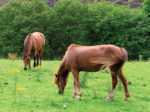Advertise Follow Us
Diseases
Overweight horses with insulin problems may be highly susceptible
Read More
Cooperate with Nature and Science When Balancing the Hoof
Advocate of Natural Balance says farriers must overcome common preconceptions about proper trimming and shoeing
Read More
Nutrition Update
Equine Diet and White Line Disease
Scottish researcher describes the connection between nutrition and the malady
Read More
Local Association Spotlight
Laminitis Data Available Online
Australian researcher Chris Pollitt posts research papers on Web for educational purposes
Read More
Navicular Problems Can Trap Farriers
Horseshoers can make first assessment of potential navicular problems, but ultimate diagnosis requires veterinary involvement to avoid liability
Read More
Tracking, Treating and Thwarting Thrush
To effectively treat thrush, the farrier sometimes needs to play detective to ferret out the root causes of the bacterial infection
Read More









